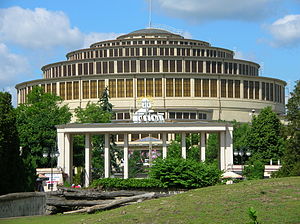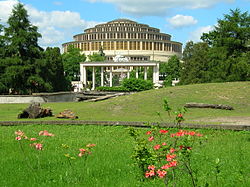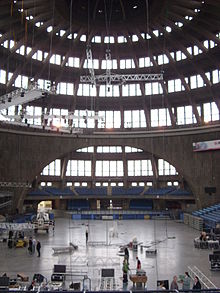- Centennial Hall
-
For other uses, see Centennial Hall (disambiguation).
Centennial Hall 
Centennial Hall after renovation in 2009Location Wrocław, Lower Silesian Voivodeship, Poland Broke ground 1911 Built 1913 Opened 20 May 1913 Operator City Hall Company Ltd. of Wrocław Architect Max Berg Main contractors Dyckerhoff & Widmann AG (Dywidag) Capacity boxing: 7,200
handball: 6,300
basketball: 7,000
volleyball: 5,400Tenants Śląsk Wrocław (Major attendance games) Official name: Centennial Hall in Wrocław Type: Cultural Criteria: i, ii, iv Designated: 2006 (30th session) Reference #: 1165 State Party: Poland Region: Europe and North America The Centennial Hall (German: Jahrhunderthalle, Polish: Hala Stulecia (formerly Hala Ludowa - People's Hall)) is a historic building in Wrocław, Poland. It was constructed according to the plans of architect Max Berg in 1911–1913, when the city was part of the German Empire. As an early landmark of reinforced concrete architecture, it was listed as a UNESCO World Heritage Site in 2006.
The building is frequently visited by tourists and the local populace. It lies close to other popular tourist attractions, such as the Wrocław Zoo, the Japanese Garden, and the Pergola with its Multimedia Fountain.
Contents
History
It was in the Lower Silesian capital of Breslau on 10 March 1813 where King Frederick William III of Prussia called upon the Prussian and German people in his proclamation An Mein Volk to rise up against Napoleon's occupation. In October of that year, at the Battle of Leipzig, Napoleon was defeated.
The opening of the hall was part of the celebration commemorating the 100th anniversary of the battle, hence the name. Breslau's municipal authorities had vainly awaited state funding and ultimately had to defray the enormous costs out of their own pockets. The landscaping and buildings surrounding the hall were laid out by Hans Poelzig were opened on 20 May 1913 in the presence of Crown Prince William of Hohenzollern. The grounds include a huge pond with fountains enclosed by a huge concrete pergola in the form of half an ellipse. Beyond this, to the north, a Japanese garden was created. The Silesian author Gerhart Hauptmann had specially prepared a play Festspiel in deutschen Reimen, however the mise-en-scène by Max Reinhardt was suspended by national-conservative circles for its antimilitaristic tendencies.
After the memorial events, the building served as multi-purpose recreational building, situated in the Exhibition Grounds, previously used for horse racing. It was largely spared from the devastation by the Siege of Breslau and after the city had become part of the Republic of Poland according to the 1945 Potsdam Agreement, the hall was renamed Hala Ludowa ("People's Hall") by the communist government. In 1948, a 106 m (348 ft) high needle-like metal sculpture called Iglica was set up in front of it. The hall was extensively renovated in 1997. Recently the Polish translation of the original German name, Hala Stulecia, is also used with reference to the history of the building.
Centennial Hall hosted EuroBasket 1963 and a preliminary round group of the EuroBasket 2009 tournament.[1]
The hall continues to be in active use for sporting events and concerts.
Construction
The cupola modeled on the Festhalle Frankfurt was made of reinforced concrete, and with an inner diameter of 69 m (226 ft) and 42 m (138 ft) high it was the largest building of its kind at the time of construction. The symmetrical quatrefoil shape with a large circular central space seats 7,000 persons. The dome itself is 23 m (75 ft) high, made of in steel and glass. The Jahrhunderthalle became a key reference for the development of reinforced concrete structures in the 20th century.
The hall was originally provided with a Sauer pipe organ built by Walcker Orgelbau, which then, with 15,133 pipes and 200 stops, ranked as the world's largest. On 24 September 1913, Karl Straube was the first to play it, performing Max Reger's Introduction, Passacaglia and Fugue for Organ Op. 127, specially composed to celebrate the occasion. Most parts of the organ were transferred to the rebuilt Wrocław Cathedral after World War II.
Access
The hall lies east of the city centre, but can easily be reached by tram or bus.
The hall is open daily to visitors for a small entrance fee.
See also
References
- ^ Kibice wywalczyli nam polskie mecze, 15 January 2007
External links
- Official site (Polish)
- Official site (English)
- Century Hall at Structurae
- archINFORM - Centennial Hall
Preceded by
1961 Final Venue
BelgradeEurobasket
Final Venue
1963Succeeded by
Palace of Sports
of the Central Lenin Stadium
MoscowWorld Heritage Sites in Poland Auschwitz-Birkenau German Nazi Concentration and Extermination Camp (1940–1945) · Białowieża Forest / Belovezhskaya Pushcha (with Belarus) · Castle of the Teutonic Order in Malbork · Centennial Hall, Wrocław · Churches of Peace in Jawor and Świdnica · Cracow's Historic Centre · Kalwaria Zebrzydowska: the Mannerist Architectural and Park Landscape Complex and Pilgrimage Park · Park Muzakowski / Muskauer Park (with Germany) · Medieval Town of Toruń · Historic Centre of Warsaw · Wieliczka Salt Mine · Wooden Churches of Southern Lesser Poland · Old City of Zamość

Coordinates: 51°06′26″N 17°04′37″E / 51.10722°N 17.07694°E
Categories:- World Heritage Sites in Poland
- Buildings and structures in Wrocław
- Indoor arenas in Poland
- 1913 architecture
- Sport in Wrocław
Wikimedia Foundation. 2010.


